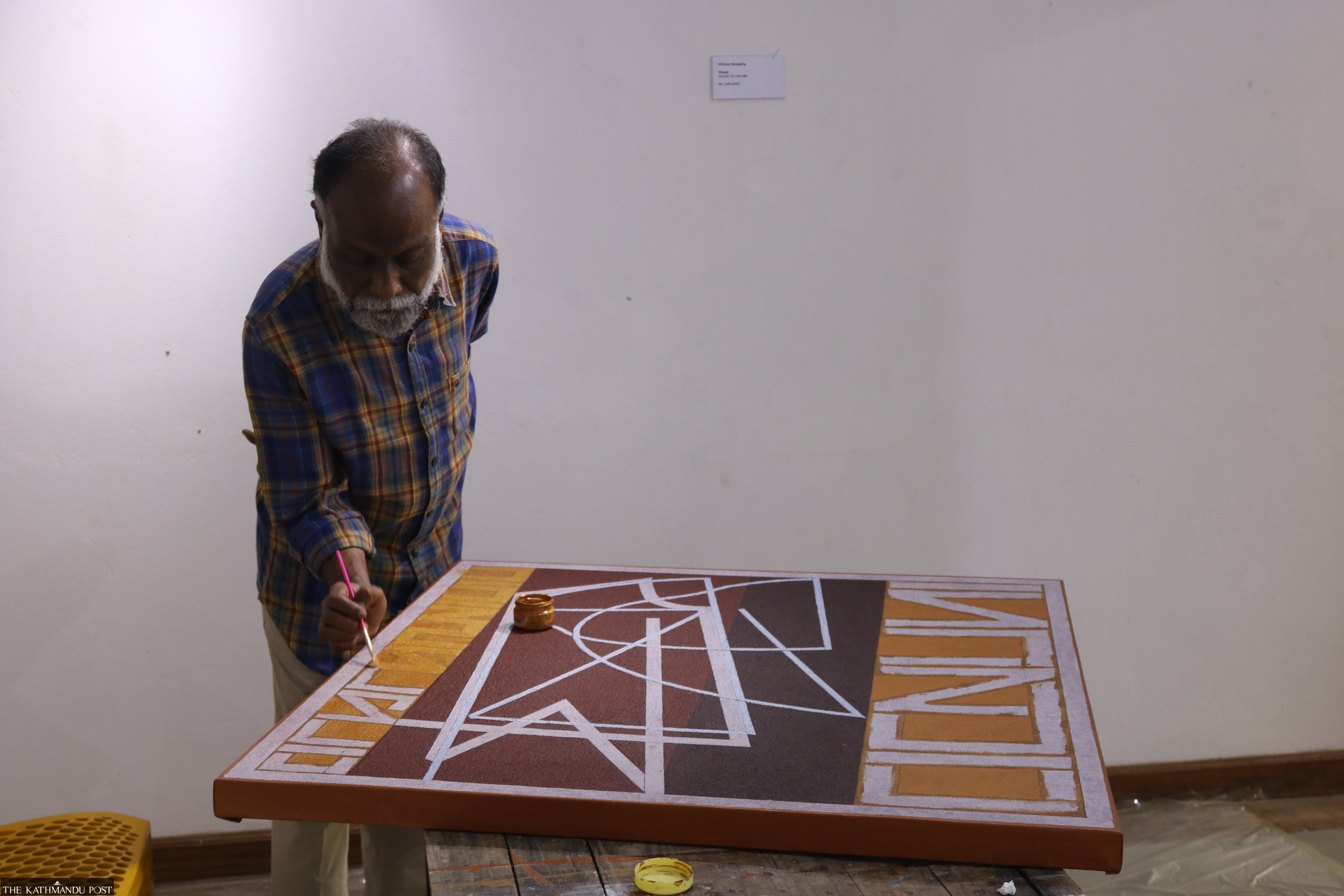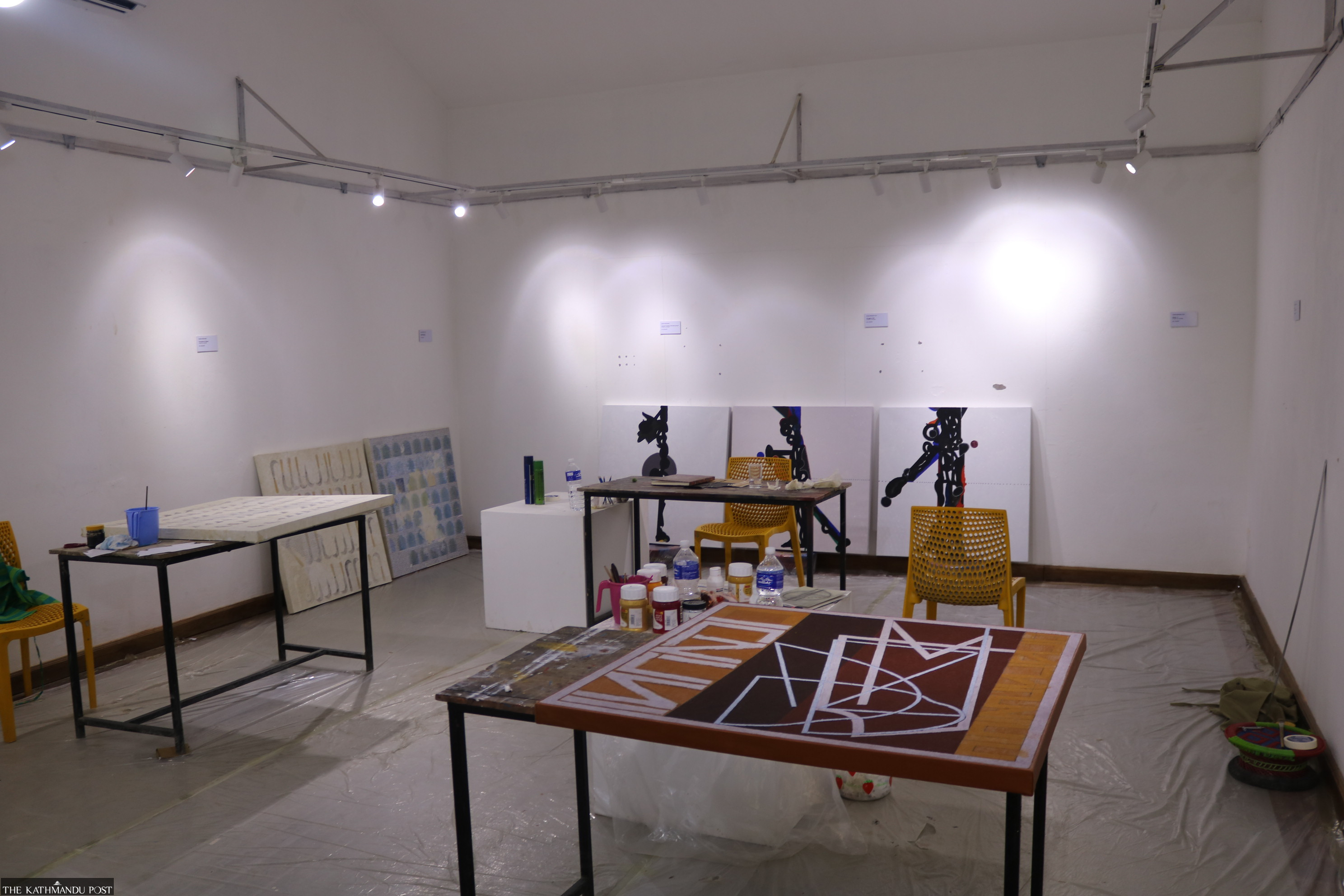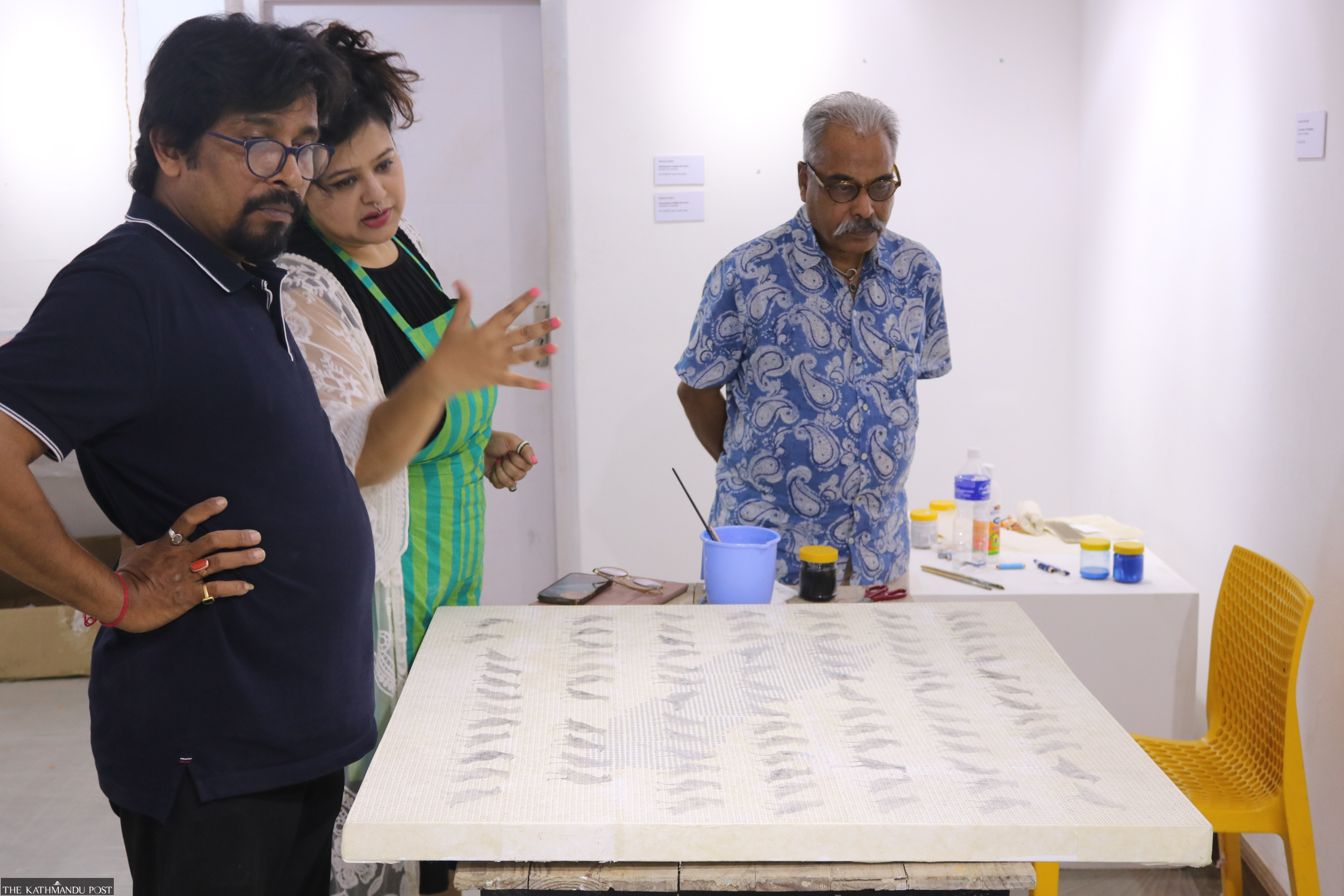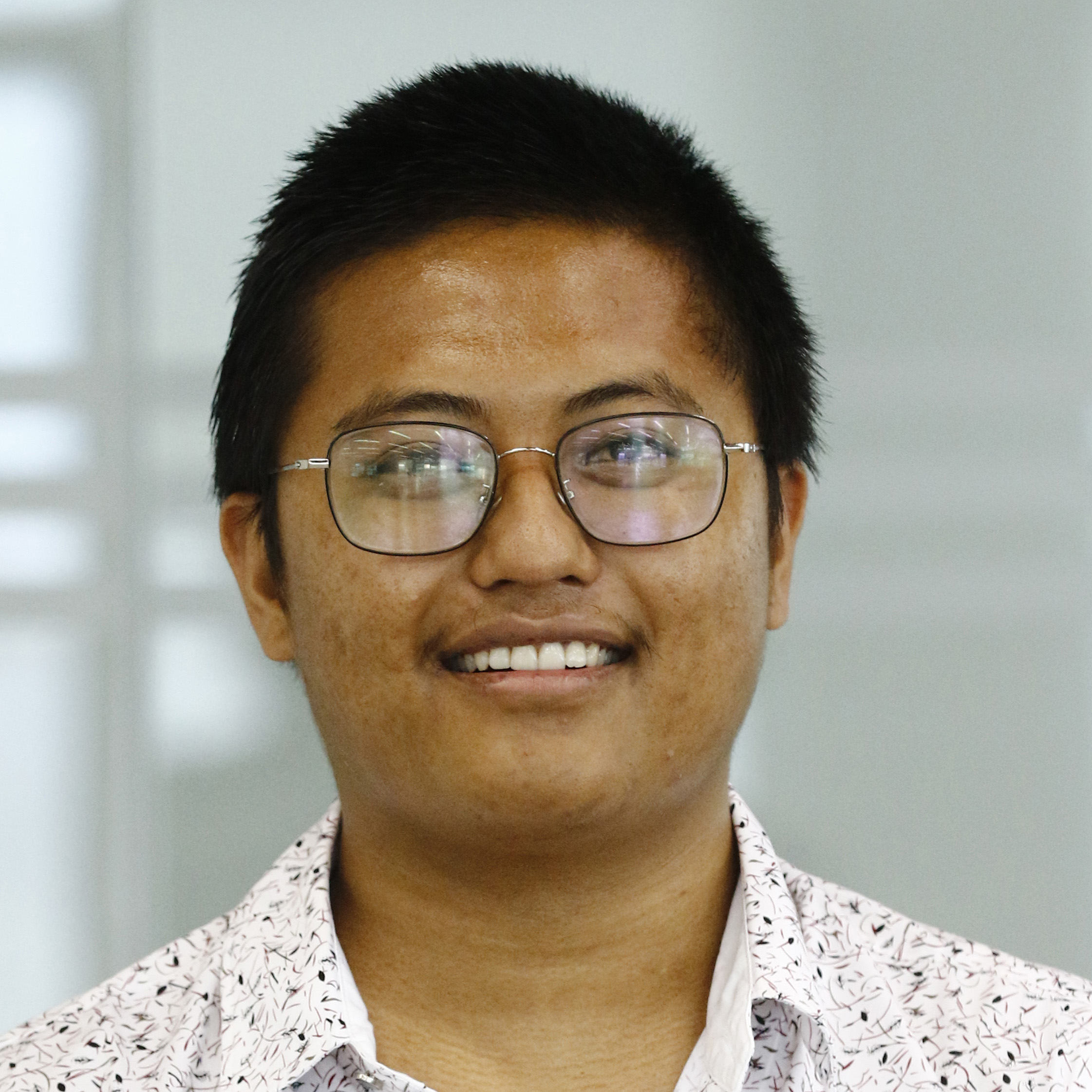Culture & Lifestyle
An attempt to foster artistic creativity and expression
An artist residency programme organised by Unnati Cultural Village and Raza Foundation hosted five Indian artists in hopes of building connections and fostering interactions.
Shranup Tandukar
Without a care for either sleep or rest, artist R M Palaniappan worked on his paintings throughout many nights.
Inspired by his fascination with aeronautics and notation systems, his artworks imbued a sense of abstraction as places and objects were reduced to lines and their subtle essence. At times, it would seem like he was finished with the painting, but then again, he would paint over the canvas and start the process of painting all over again.
“We see human culture mostly in physical manifestations such as buildings, streets, and statues,” he said. “But the psychological perception of culture dominates my artwork. I want to capture the essence of culture that’s on my mind onto my canvas. But, my mind is in constant flux.”
Palaniappan was part of an international art residency programme organised by Unnati Cultural Village(UCV) and Raza Foundation, wherein five Indian artists stayed in UCV in Gaindakot municipality, Nawalpur, for almost three weeks, from April 4 to April 24. The other four artists—Amitava Das, Manish Pushkale, Tanmoy Samanta, and Wahida Ahmed—are renowned Indian artists who have been part of many national and international art residency programmes. After a brief visit to Patan, Bhaktapur, and Kathmandu after their arrival in Nepal, the artists spent the majority of their stay in the serene environment of UCV, immersed in their surroundings and focused on their art. They created three artworks each, using acrylic or oil paints, on stretched canvases.

On a property that sprawls over six bighas of land, UCV is an idyllic destination designed to be a retreat into nature and a place that fosters artistic inspiration. Established in March 2021, UCV houses a Nepali arts museum, Tharu-culture-styled rooms, open-air art museum spaces for local artists, workshop space for artists, an organic garden, and finally Kala Ghar, which houses rooms especially made for art enthusiasts.
Amrit Karki, an independent curator and artist, was the curator of the art residency programme. Having worked as a curator in various art exhibitions before, notably ‘Homage’, a mixed media art exhibition in 2017 in Taragaon Museum, he believes that curators have the ability to bring the artworks of artists to the forefront of the art world. “A curator’s job is to not only showcase artwork but also enhance it. I noticed a lack of such skills in curators in Nepal, so I started to develop curation skills myself even though my priority lies in creating art myself,” he said.
Karki shares that art residencies have the ability to inspire artists because of the freedom as well as the limitations they provide. “The time limit in art residencies can create newfound inspiration, but artists also have the freedom to explore beyond their comfort zone.”

Manish Pushkale, one of the highly regarded painters in India, believes that art residencies create an ideal internal and external environment for artists to explore their creativity.
“Art residencies are usually conducted near nature or at creative centres in cities. Such locations create a conducive external environment for artistic expression,” he said. “However, another factor about art residencies is that artists are given the freedom to explore and create art as they see fit without any restrictions to have internal dialogues about their artistic vision.”
Pushkale, in his artworks, carries a strong sense of abstraction. He hasn’t received academic training in art, but he hasn’t allowed the lack of academic know-how to hinder him. As a child, he used to run away from his school classes and sneak into the premises of Bharat Bhavan, an autonomous multi-art complex and art museum in Bhopal, India. These trips would eventually instil a deeply-ingrained passion for art, and though he became a trained geologist, the love of art eventually made him change his career track.
“I think that art institutions and places like UCV, which foster artistic endeavours, are incredibly important for a society. I am a living example of how exposure to art, especially contemporary art, in museums and art institutions for young children can instil a deep appreciation for art and create more artists in society,” Pushkale added.
Amitava Das, an artist based in New Delhi, has been involved in the art world for more than 50 years. He was one of the senior-most artists in the art residency programme, but he believes that age doesn’t matter so much in art.
“Art is ageless, and it is eternal. You cannot determine the artistic capabilities of artists by their age,” he said.
There is a prominent theme of the dual nature of human beings in paintings by Das. The possibility of human beings as both saviours and destroyers of the world fascinates him, and this fascination is often translated into his artworks.
However, in the art residency programme, he tried to let go of his usual approaches to his art and let the surroundings and local influences guide him.
“Artists generally work in their own studio, which is catered specifically to their tastes. However, here[in UCV], the space is totally different and it is very, very challenging,” he said. “We can devote our entire time to art, and since we are with fellow artists, we can also learn from each other. We use different techniques and mediums in our art, and we can learn new things from observation.”
The sentiment that art residencies create an effective learning environment for established artists is also echoed by another artist Wahida Ahmed. “All of us knew about each other before we were part of this art residency because we are part of the same art fraternity,” said Ahmed. “However, we didn’t have an opportunity to closely observe each other or understand how each of us approaches art before this.”

Ahmed is an artist based in Assam, India, and she tries to incorporate the indigenous and local elements of Assam in her artworks. She is especially fond of the idea of weaving, which is an integral part of Assamese culture, as she tries to create artworks using techniques and traditions of weaving. The themes of mythological references to classical texts and images of contemporary times are prominent in her artworks.
In one of the artworks she made during the artist residency, multiple images of crows are placed on top of a dotted map of Nepal. The duality of crows—as both a harbinger of good news and bad news—was emphasised by showing the crows face in different directions. In another, she dissected the map of Nepal and superimposed the parts on top of a dotted pattern and window images to create another version of Nepal.
Tanmoy Samanta’s artworks are imbued with symbolism, and his themes often feature geometric abstraction. An artist based in West Bengal, India, he was interested in art from a young age, and his parents encouraged his passion for arts too. His artistic journey started in Kala Bhavan, West Bengal, and he also trained at Kanoria Arts Centre, Ahmedabad.
As a participant of many national and international art residencies, he believes that art residencies are important landmarks in the life of an artist.
“Compared to the art residencies in Spain or the USA, this art residency in Nepal is like experiencing an extension of India. The surroundings are similar, but I am experiencing them in different ways here,” said Samanta. “The aim for a residency programme is not to have an end product. It’s a space and time afforded to artists to engage in the process of expanding and enriching their artistic visions.”
Pushkale, a trustee of Raza Foundation, had visited UCV back in February in preparations of the artist residency programme. He believes that artist residency programmes like this are important as a bridge between two different cultures, communities, and even nations.
“This initiative by UCV and our Raza Foundation is a stepping stone to a more interactive relationship between Indian and Nepali artists,” he said. “We have planned more residency programmes like this for the future, and we plan to expand them to create an art fostering environment.”




 16.12°C Kathmandu
16.12°C Kathmandu















